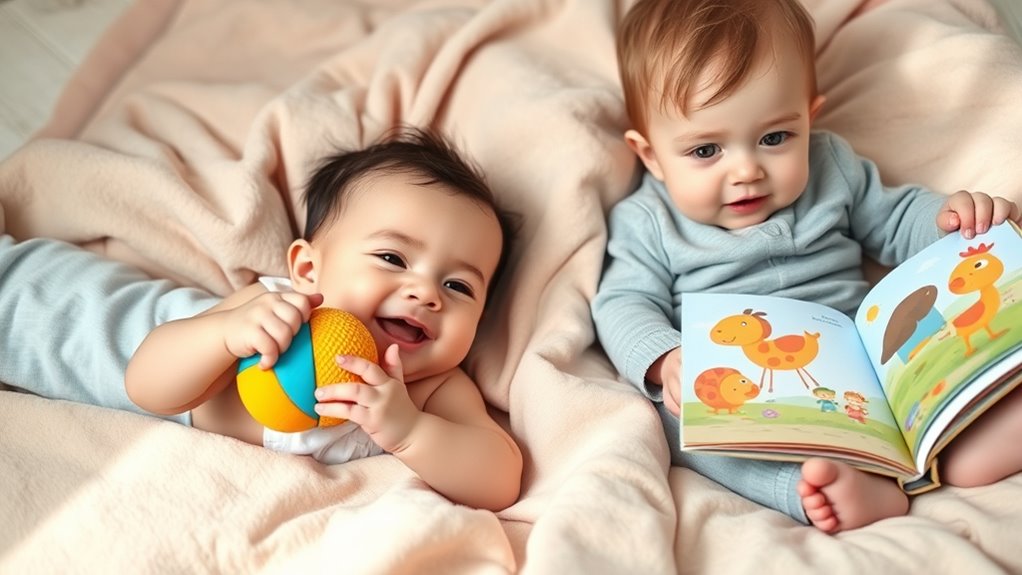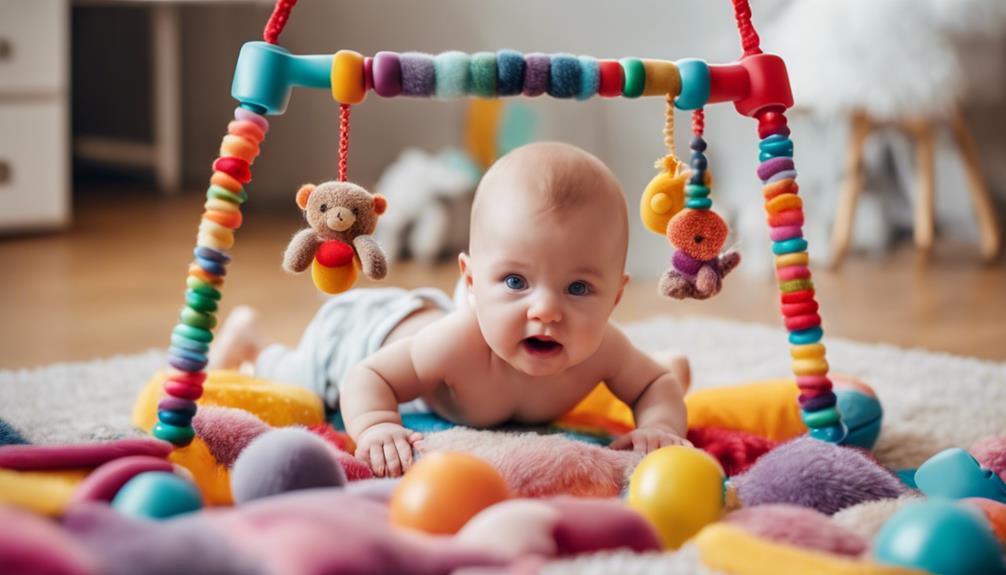In the first two years, your child starts recognizing familiar voices and faces, responds to sounds, and shows curiosity by exploring objects. They develop object permanence, meaning they realize objects still exist when out of sight, and begin using words and gestures to communicate. They also imitate actions, follow simple instructions, and explore sensations through sensory play. As they progress, their curiosity and problem-solving skills grow—if you keep engaging them, you’ll see even more exciting developments unfold.
Key Takeaways
- Recognizing and responding to voices and faces, establishing emotional bonds and sensory awareness.
- Developing object permanence, understanding that hidden objects still exist.
- Engaging in sensory play to stimulate multiple senses and promote neural growth.
- Acquiring early language skills, including first words and gestures like pointing.
- Achieving cognitive milestones such as following simple instructions and imitating actions.
Recognizing and Responding to Voices and Faces
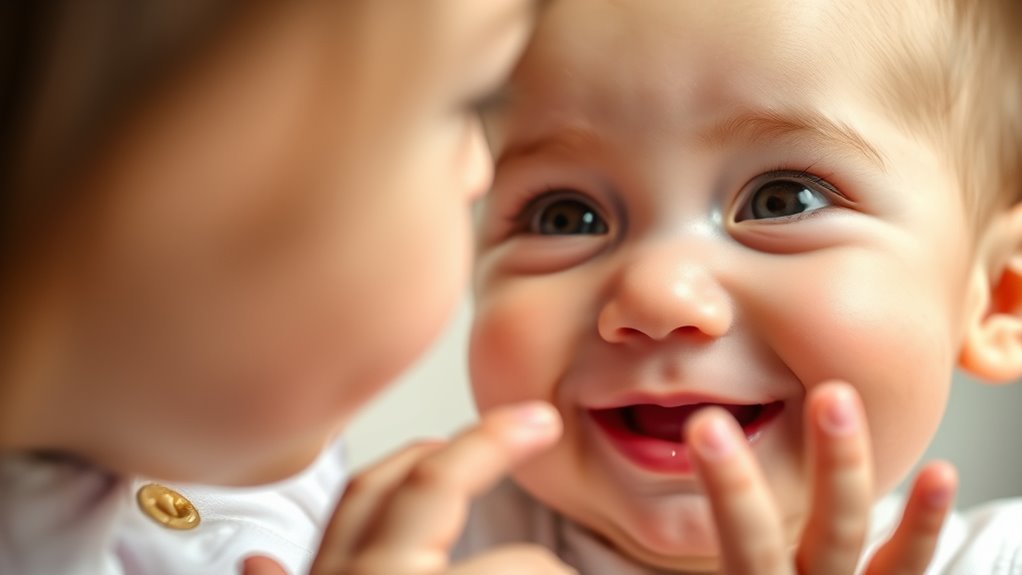
From the moment babies are born, they start to recognize and respond to voices and faces, laying the foundation for social interaction. You’ll notice your baby responding to your voice, turning their head toward familiar sounds, and calming when they hear your voice. They also begin to notice facial expressions, distinguishing smiles from frowns, which helps them interpret emotions. Voice recognition becomes stronger as they listen to your voice repeatedly, creating a sense of security. Early on, babies can even differentiate between familiar voices and strangers, showing preference for loved ones. These responses are vital steps in cognitive development, helping your baby connect with others and build trust. By paying attention to facial expressions and voice cues, you’re supporting their social and emotional growth from the very start. Additionally, exposure to high-quality audio and visual stimuli can enhance their sensory development, fostering more complex recognition skills over time. This early sensory engagement supports neural connections, which are crucial for overall cognitive milestones. Engaging your baby with consistent face-to-face interactions and varied sounds can further stimulate their developing sensory and neural pathways.
Developing Object Permanence
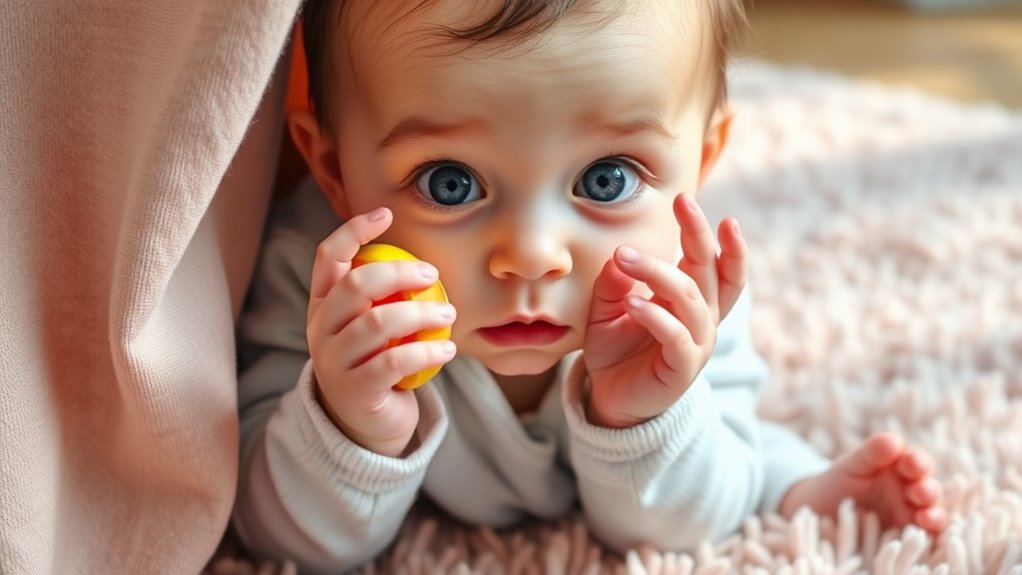
As your baby becomes more attuned to voices and faces, they also start to understand that objects continue to exist even when out of sight. This understanding marks a key cognitive milestone called object permanence. During this stage, your little one begins to search for hidden toys or peek behind objects, realizing that things haven’t disappeared. It’s a sign they’re developing memory and awareness of the world around them. As their cognitive skills grow, they’ll become more persistent in finding objects, showing increased curiosity and problem-solving abilities. Developing object permanence is essential in their overall cognitive development, helping them build a sense of security and trust that the world is stable even when they can’t see everything at once. Incorporating vintage decor and natural materials can also stimulate their developing senses through visual and tactile exploration. Additionally, engaging in safe exploration activities can further support their curiosity and learning.
Exploring Through Sensory Play
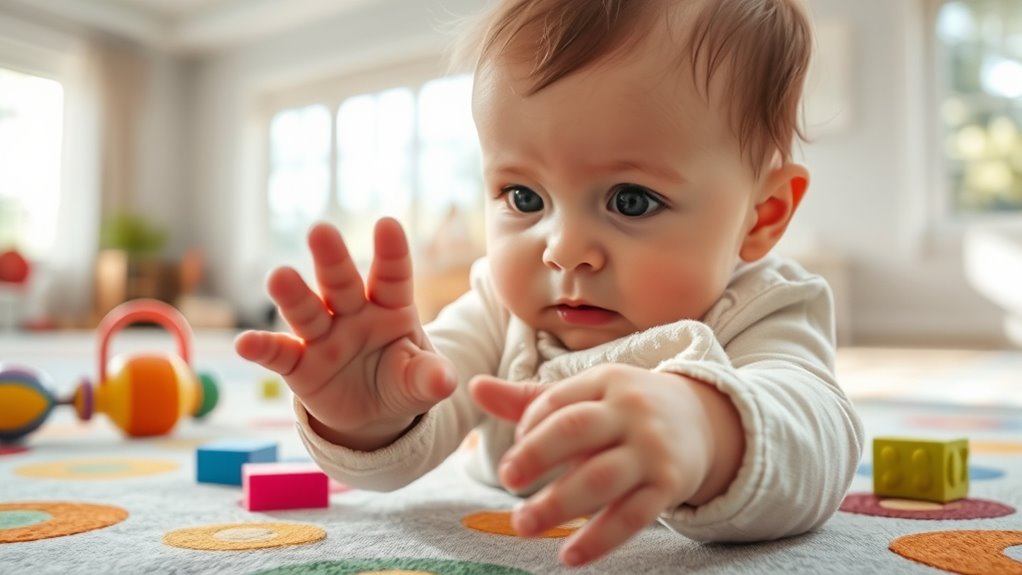
You can encourage your child’s learning by introducing sensory exploration techniques that stimulate multiple senses. Using simple activities like feeling different textures or listening to various sounds helps develop their cognitive skills. Engaging their senses in these ways makes exploration both fun and educational. Incorporating early developmental milestones into play can further support their growth during these critical months. Additionally, understanding newborn sleep patterns can help you create a consistent and soothing environment that promotes healthy development.
Sensory Exploration Techniques
Have you ever wondered how young children learn about their environment? Sensory exploration techniques play a crucial role in this process. You can encourage tactile stimulation by providing soft fabrics, textured toys, or different household objects for your child to touch and feel. This helps develop their sense of touch and fine motor skills. Simultaneously, engaging in activities that promote visual tracking, like waving colorful toys or moving objects slowly across their line of sight, sharpens their ability to focus and follow movement. These techniques stimulate curiosity and strengthen neural connections related to sensory processing. Additionally, incorporating sensory development milestones into your activities ensures a well-rounded approach to your child’s growth. Understanding sensory processing can guide you in tailoring activities to your child’s current abilities. Incorporating a variety of sensory experiences can further enhance neural pathways and support overall cognitive development. Utilizing natural materials in toys and activities can enrich sensory input and promote holistic development. By intentionally creating opportunities for tactile exploration and visual tracking, you support your child’s cognitive growth and help lay the foundation for later learning and exploration.
Stimulating Multiple Senses
Engaging multiple senses through sensory play enriches a child’s learning experience by integrating sight, sound, touch, taste, and smell. You can promote this by introducing activities like music therapy, which stimulates auditory and emotional development, and tactile stimulation, such as textured toys or textured fabrics. These activities help your child explore different sensations, fostering neural connections essential for cognitive growth. By varying sensory inputs, you encourage curiosity and attention span. Incorporate gentle sounds, vibrant visuals, and diverse textures into playtime to keep your child engaged and learning. Remember, sensory play isn’t just fun—it’s a crucial tool for developing their perceptual skills, language, and problem-solving abilities in these formative early years. Additionally, incorporating dog breeds with distinctive features into activities can further broaden their sensory experiences and understanding of the world around them. Recognizing that sensory development plays a vital role in overall cognitive progress helps tailor activities to support your child’s growth comprehensively. Moreover, engaging in multi-sensory activities can boost neural pathways and enhance overall brain development during this critical period.
Beginning to Use Words and Gestures
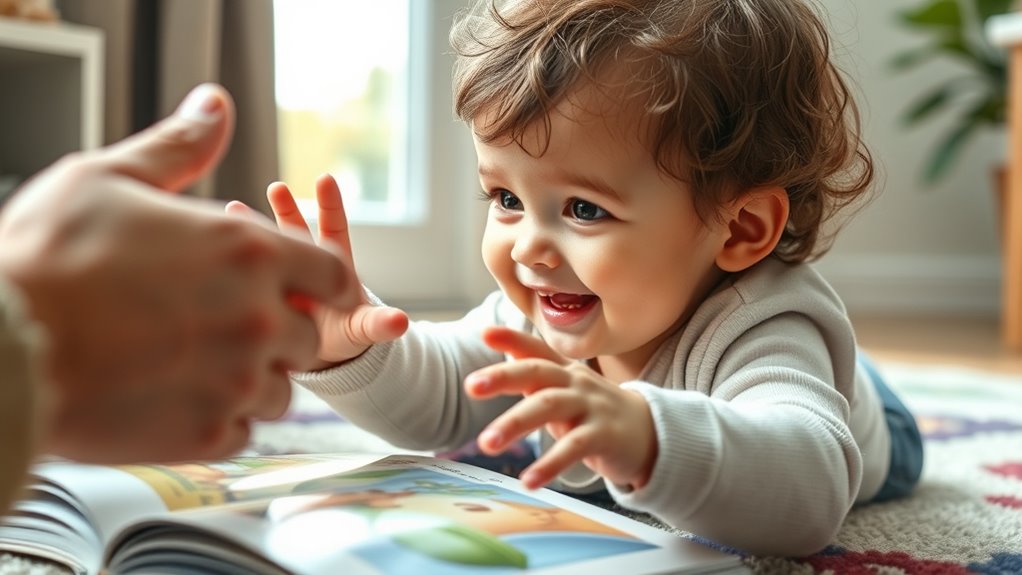
As your child begins to use words and gestures, you’ll notice them saying their first words and waving or pointing to communicate. They start recognizing names and objects, which helps them connect words to their meanings. This stage marks their growing ability to share thoughts and understand the world around them. Additionally, you may observe their developing use of vocabulary, which is essential for effective communication. Understanding language development milestones can help you support their progress effectively. Recognizing early communication behaviors can also encourage their confidence in expressing themselves. Supporting their emotional regulation can further enhance their ability to communicate effectively.
First Words Emerge
When do babies start using their first words and gestures? Typically, around 12 months, your baby begins to reach key language milestones, using simple words like “mama” or “bye.” These early words mark a big step in social interactions and communication. You might notice them pointing or waving as they link gestures with words. Here’s a quick overview:
| Age Range | Milestone | Example |
|---|---|---|
| 9-12 months | First recognizable words | “Dada,” “Ball” |
| 12-18 months | Combining words and gestures | “More juice” |
| 18-24 months | Expanding vocabulary | Names, actions |
This phase is exciting—your baby is building the foundation for language and social connection. Additionally, the emergence of first words and gestures often coincides with their developing cognitive skills and curiosity about their environment, driven by increased neural development that supports communication. Understanding how these milestones align with cognitive development can help parents support their child’s language growth effectively.
Gesture Communication Develops
Around 12 months, your baby starts to combine gestures with spoken words, marking an exciting phase in their communication skills. They become more aware of nonverbal cues, using gestures like pointing or waving to share their needs and interests. These gestures often accompany their first words, helping them express themselves more clearly. Some babies even begin to use simple sign language, like “more” or “all done,” to communicate before they can speak. This development shows they’re understanding the connection between gestures and language, enhancing their ability to interact with others. As they experiment with combining words and gestures, your little one gains confidence in sharing their thoughts, setting the stage for more complex communication skills ahead.
Recognizing Names and Objects
Your baby begins to recognize familiar names and objects, making connections between words and their meanings. You’ll notice your little one responding when you say their name or point to a favorite toy, demonstrating early object identification. This stage marks the beginning of name recognition, as your baby starts associating sounds with specific people or items. They may turn their head or look directly at the object when it’s named, showing understanding. Using gestures along with words helps reinforce these connections. As their cognitive skills develop, your baby will become more adept at recognizing objects and names in different contexts. This progress builds a foundation for more advanced language skills, such as simple words and phrases. Keep encouraging their curiosity by naming objects and repeating their names often.
Understanding Simple Instructions
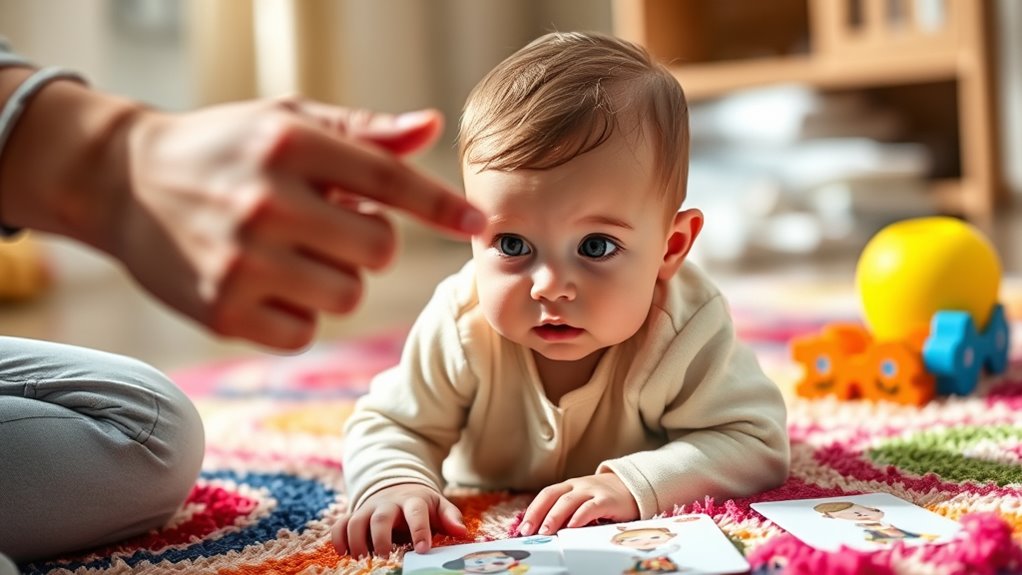
How do young children begin to understand simple instructions? It starts with their developing language comprehension, which allows them to process and interpret what you say. Around 12 months, children begin to follow simple directions like “bring the ball” or “sit down,” demonstrating their growing ability to connect words with actions. As their understanding improves, they become more adept at following directions that involve multiple steps, showing progress in their cognitive skills. This milestone indicates they’re grasping the relationship between language and behavior. Your consistent, clear instructions help reinforce this learning. Remember, patience is key—each child develops at their own pace. By 18 months, many children can understand and follow simple instructions, laying the foundation for more complex communication skills later on.
Imitating Actions and Sounds
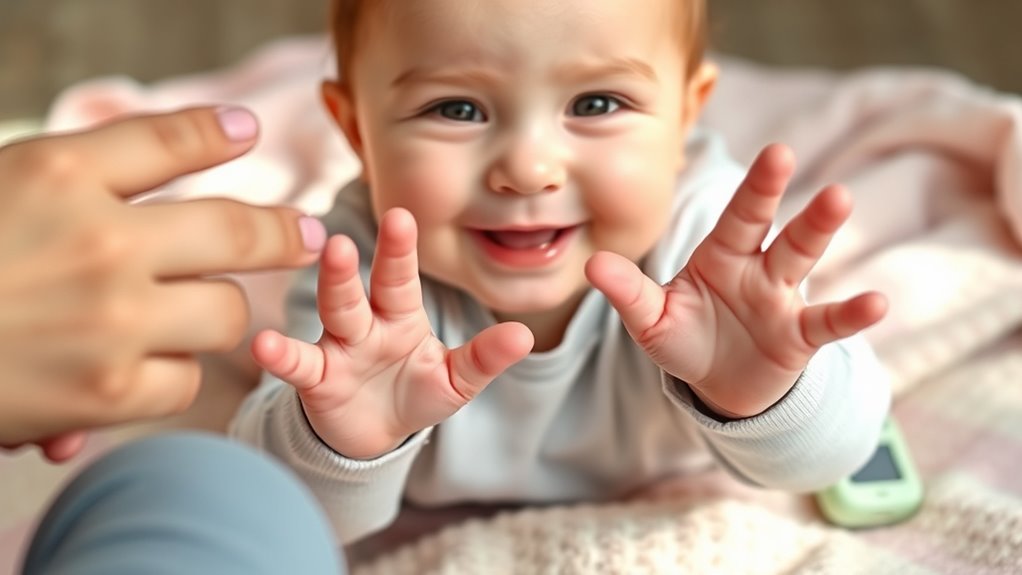
As children begin to understand and follow simple instructions, they also start experimenting with copying actions and sounds they observe. Social imitation becomes a key way they learn from others, helping them develop communication skills and social awareness. You might notice your little one copying your gestures or facial expressions, which shows their growing ability to imitate actions. Sound mimicry also emerges as they try to replicate noises, words, or tones they hear around them. This practice isn’t just adorable; it’s essential for language development and understanding social cues. By imitating actions and sounds, your child is building neural connections that support future learning, communication, and social interaction. Encourage their efforts with praise and gentle guidance to foster their confidence and curiosity.
Showing Curiosity and Problem-Solving Skills

Children naturally become more curious about their surroundings as they explore and interact with the world around them. During this time, you’ll notice them using curiosity-driven learning to understand how things work. They start experimenting with problem-solving strategies, like opening containers or fitting shapes into matching holes. You can encourage this by offering safe, interesting objects that invite exploration. As they encounter obstacles, they learn to test different approaches, building their ability to think critically. This stage is essential for developing persistence and creativity. By supporting their curiosity and providing opportunities for hands-on problem solving, you help foster their natural desire to learn and discover. Your encouragement empowers them to become confident, independent thinkers as they navigate their environment.
Frequently Asked Questions
How Can Parents Support Cognitive Growth During Early Milestones?
You can support your child’s cognitive growth by encouraging sensory exploration, allowing them to experience different textures, sounds, and sights. Engage in language stimulation through talking, reading, and singing, which helps develop their understanding and communication skills. Respond to their curiosity with enthusiasm and patience, fostering an environment where they feel safe to explore and learn. Your active involvement boosts their brain development during these vital early milestones.
What Are Common Signs of Developmental Delays in Infants?
You should watch for signs of developmental delays, like not smiling by six months, not responding to sounds, or missing motor milestones. If you notice these, early intervention and developmental screening become vital. Addressing concerns early helps support your child’s growth and can improve outcomes. Trust your instincts and consult healthcare professionals promptly to guarantee your little one gets the support they need to thrive.
How Does Sleep Affect Cognitive Development in the First Two Years?
You might wonder how sleep affects cognitive development in the first two years. Sleep patterns and nap routines play a crucial role, as adequate rest helps your baby process new information and develop brain connections. When your little one follows consistent sleep schedules, it boosts their learning, memory, and problem-solving skills. Prioritizing good sleep habits supports their overall growth and helps them reach important developmental milestones.
When Should I Be Concerned About My Child’s Progress?
Think of your child’s growth as a journey through a storybook. You should be concerned if they miss early language milestones like babbling by 12 months or don’t respond to social attachment cues like eye contact by 9 months. If progress stalls or seems delayed, it’s wise to consult a pediatrician. Early signs matter, and catching concerns early helps your child thrive in their developmental adventure.
Are There Specific Activities to Boost Problem-Solving Skills Early On?
You can boost your child’s problem-solving skills early on with engaging cognitive activities and problem-solving games. Encourage them to explore toys that challenge their thinking, like puzzles or shape sorters. Playing simple games that require them to find solutions or make choices also helps develop their skills. Regularly introducing new activities keeps their mind active and promotes growth in critical thinking and problem-solving abilities from a young age.
Conclusion
By the age of two, most children recognize voices and faces, and about 90% understand simple instructions. You’ll notice your little one exploring with curiosity, using words and gestures to express themselves, and solving tiny problems daily. These milestones show how quickly they grow and learn in just two years. Keep engaging and encouraging their curiosity—you’re helping them build a strong foundation for future learning and discovery!

